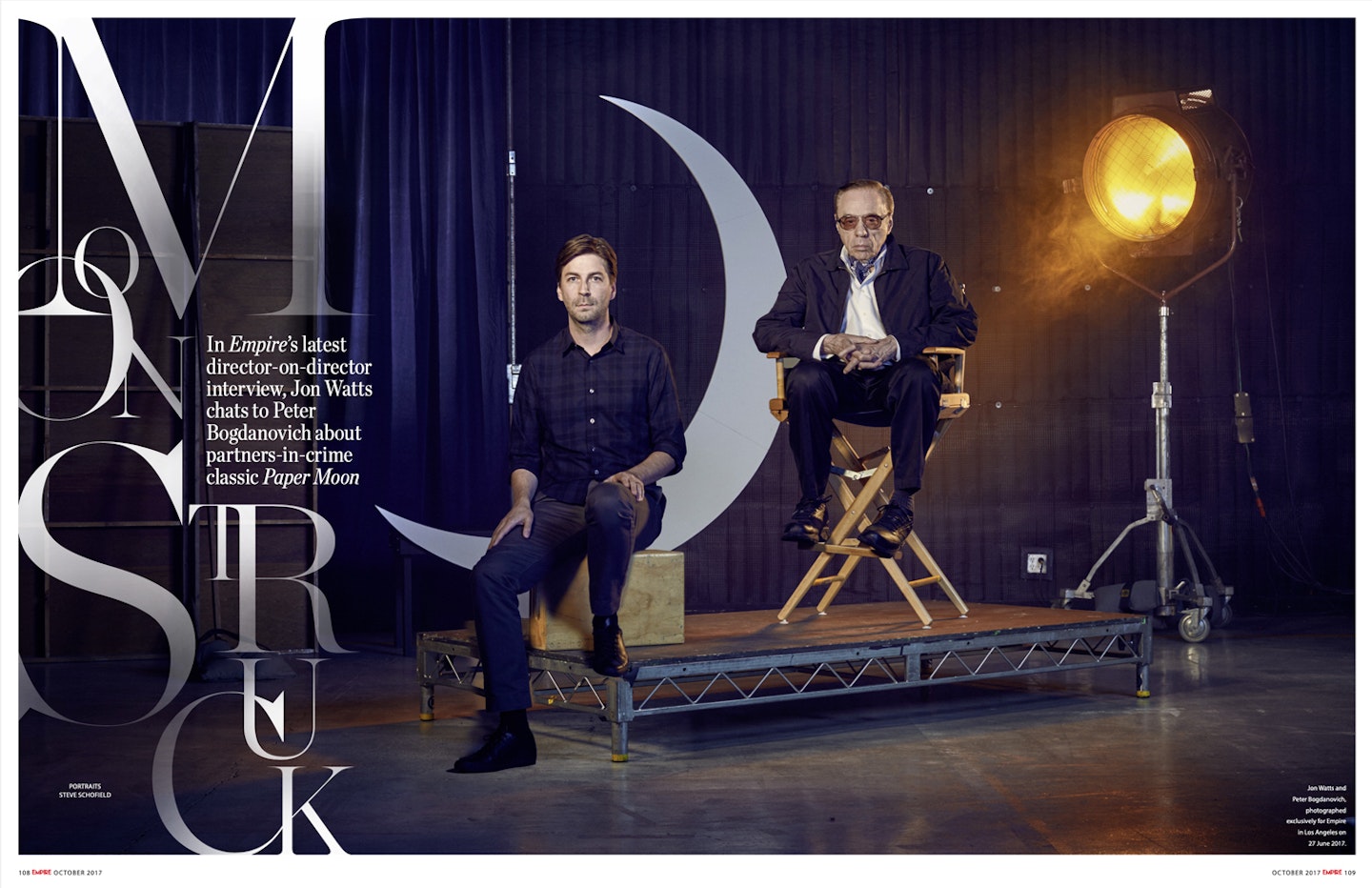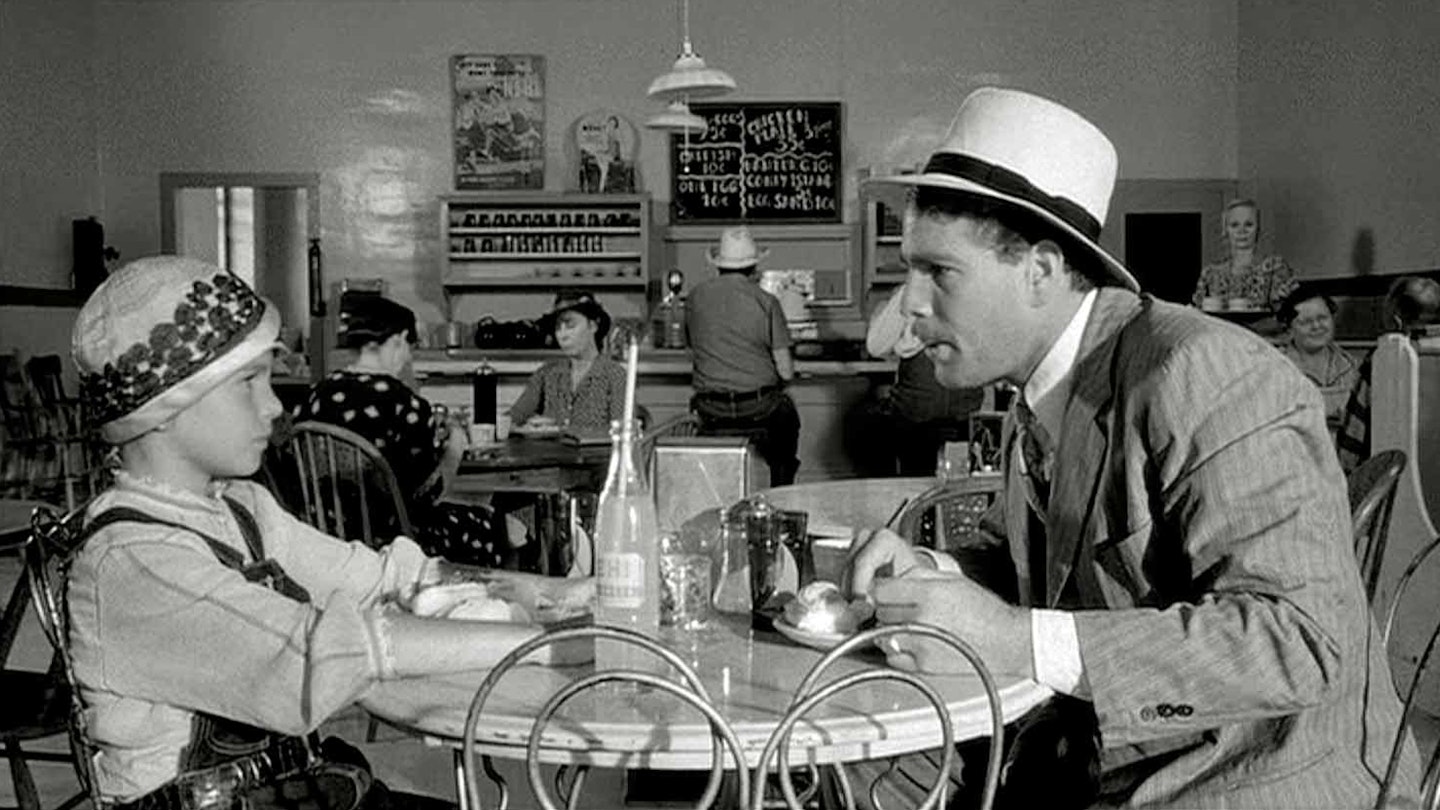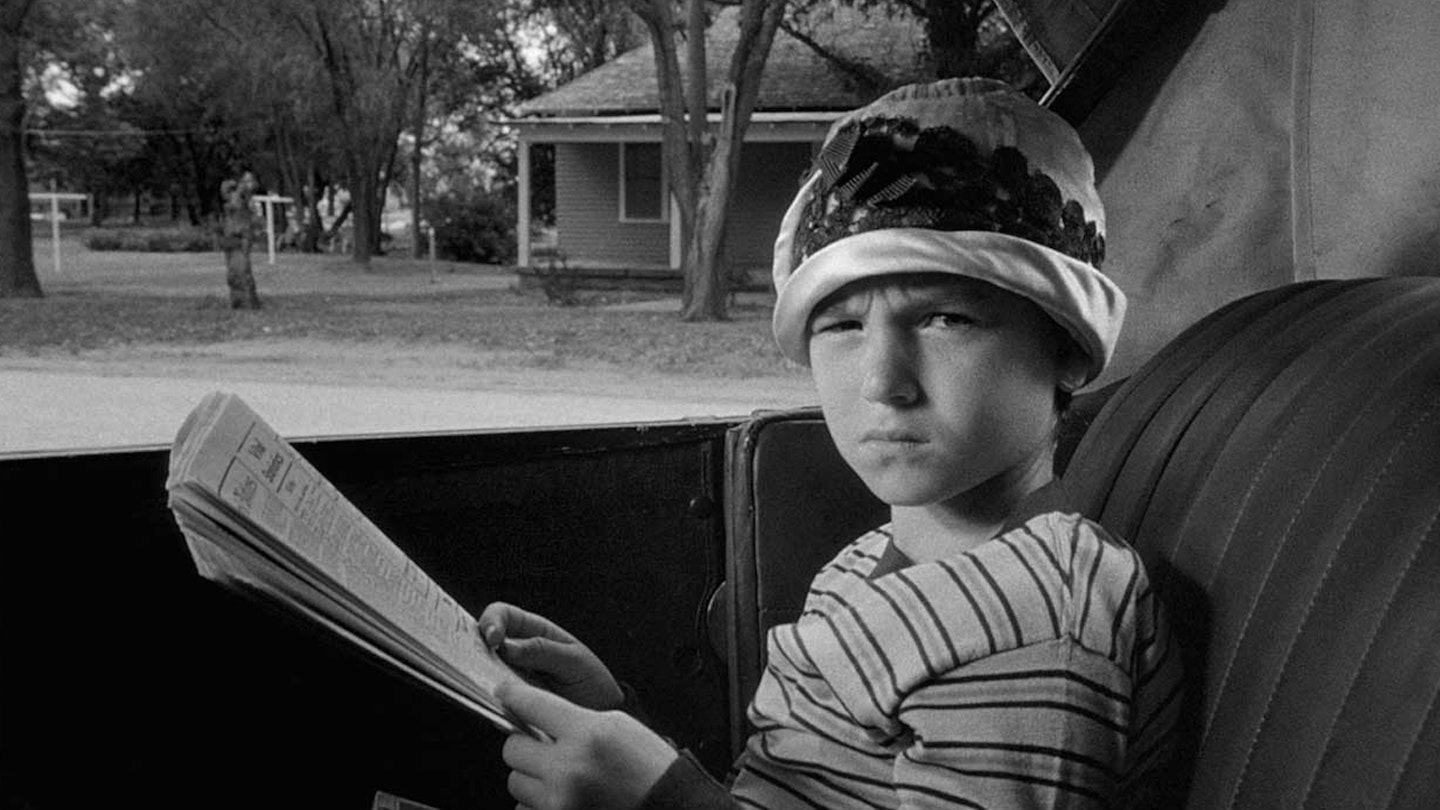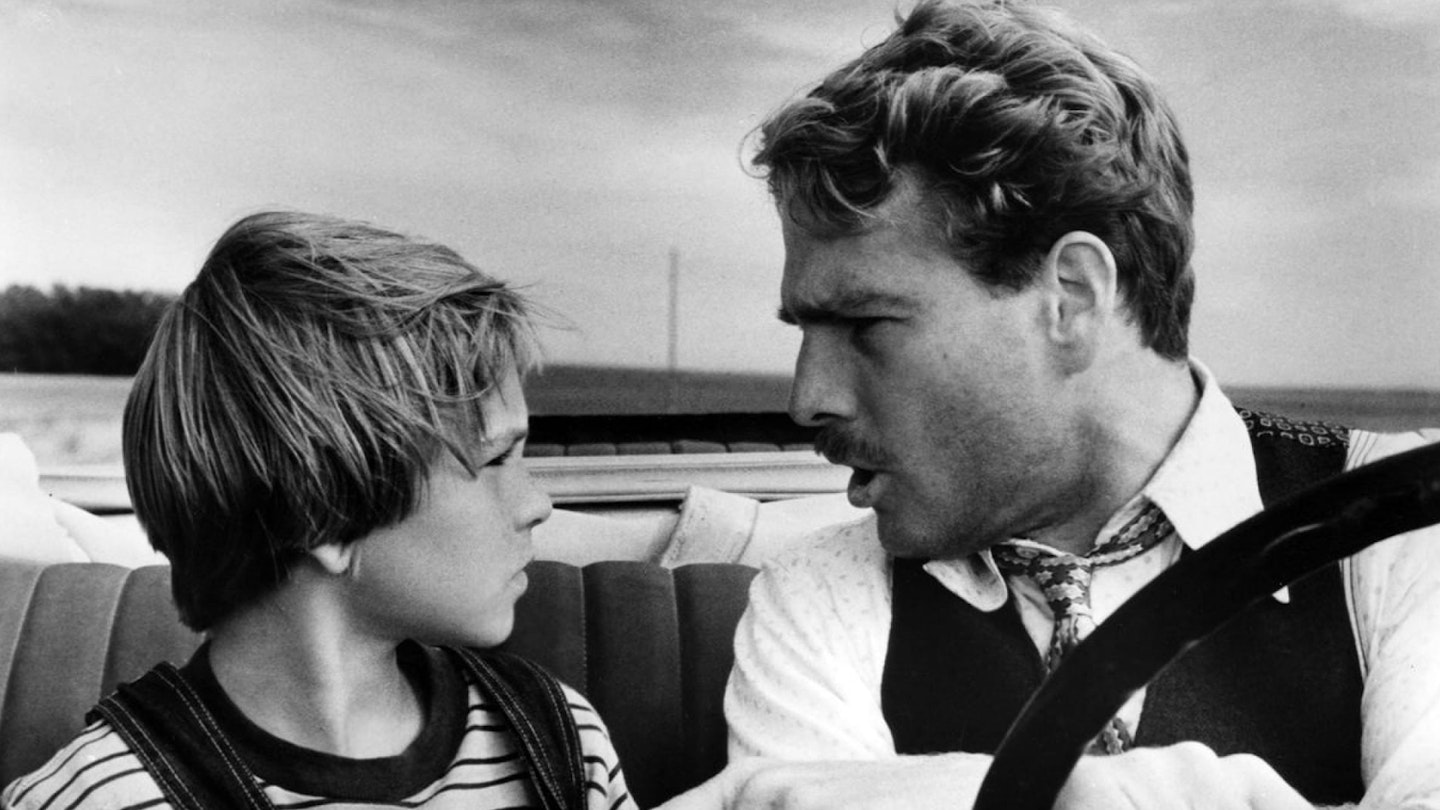In 2017, Hollywood legend Peter Bogdanovich sat down with rising filmmaker Jon Watts (after his debut Cop Car and Spider-Man: Homecoming, but prior to Far From Home and No Way Home) for a director-on-director interview, in which Watts dug into the making of Bogdanovich’s 1973 classic Paper Moon. To mark Bogdanovich’s passing at the age of 82__, Empire presents the interview in full.
———

When I first saw Paper Moon as a kid, I didn’t understand what section of the video store it belonged in.
The story of two con artists — a man named Moses Pray (Ryan O’Neal) and the nine-year-old Addie Loggins (Tatum O’Neal) who poses as his daughter — it was set during the Depression and filmed in black-and-white, but the VHS box claimed it was made in the ’70s and was a comedy. There were curse words and sexual innuendo but it had a sweetness and humour that felt different from the other ‘classic’ ’70s films I was watching. It was a complete outlier and I loved it from the moment I saw it.
As I learned more about the craft of filmmaking, I returned to Paper Moon many times, always discovering new details that deepened my appreciation for the film — the long takes, the use of music, the immaculate production design. To me, there are few films that feel as complete. It’s hard to imagine it being filmed; it’s as if the film reels just appeared, fully formed and ready. I wanted to talk to Peter Bogdanovich because I wanted to know how he made something so precise look so effortless.
Peter is the ultimate interviewer of directors, so I was understandably nervous about talking to him. Who The Devil Made It, his collection of interviews with classic filmmakers, is essential reading for anyone who cares about how films are made. I was worried he’d roll his eyes at my questions. Instead, I found myself sitting across from someone who seemed as excited about his films as when he made them. He loves talking about the process, the happy accidents, the gossip. The thing that doesn’t come across in written interviews with Peter is that when he’s telling a story about an old star, director or producer, he’s doing an uncanny imitation of them. It’s as if he’s a medium and all the ghosts of old Hollywood are speaking through him.
It was a dream come true, and I left the interview feeling inspired and with a whole new list of questions that I wanted to ask about his other films. I hope I get the chance.

Jon Watts: It’s so good to meet you. You showed The Cat’s Meow when I was at NYU and I remember there was a big Q&A but I didn’t get a chance to talk to you afterwards. I’ve always wanted to.
Peter Bogdanovich: Well, here we are.
Watts: I tried to come up with some questions that are not the ones everyone has asked for a thousand years about Paper Moon, and I’ve found that directors love the movie. Everyone loves it, but directors seem to especially love it. It’s always on Top Ten Films Of All Time lists. I was trying to figure out why that is, and I think it’s because there’s a precision to it you don’t always see in films. I have a hard time imagining shots that were cut out. Were there any?
Bogdanovich: Nothing.
Watts: It must’ve taken you five minutes to edit!
Bogdanovich: We actually showed it to the studio three weeks after we wrapped, at Christmas. It was on reels back then. The penultimate reel ends with [Addie] going into Aunt Billie’s. The door closed and the lights came up and everybody said, “Is that the end?” I told them, “No, no, it’s a mistake!” and went back to the projection room. Most of the major directors I spoke to in my interviewing days only shot what they needed.
Watts: That was a way to maintain control in the studio system too, right?
Bogdanovich: It was indeed. There’s a great story about [John] Ford. Someone said, “Shall we get a close-up of Walter under the tree?” And he said, “Oh Jesus, no! They’ll just use it.”
We did [the driving scene] 25 times the first day! It was the most difficult scene in the picture – Peter Bogdanovich
Watts: [Laughs] Every time I watch Paper Moon, I pick up something new. I was watching it again last night and one thing I realised this time was how often you use a song and cut it off in the middle of a line. The songs that are playing never resolve in the scene. At the hotel, Addie is listening to ‘A Picture Of Me Without You’, and it cuts right before it says “you”. And then there’s the scene later on when they’re spying on the bootlegger for the first time and there’s ‘Nobody’s Darlin’ But Mine’, and right as the lyrics say, “My momma’s dead in heaven, my daddy...” you cut. The songs never finish the sentence.
Bogdanovich: The whole idea was to make it feel like it’s realistic, the action is just happening. But I stole the idea of using no score from Rear Window, Hitchcock’s picture. He has a score at the start and at the end, but all through the rest of the picture, nothing. Just sounds — a record playing or something. I’ve used it for virtually all the pictures I’ve made. I think I used a score in At Long Last Love and Nickelodeon. The next picture I’m going to direct is a fantasy film that has ghosts in it and I might use a score for that.
Watts: It’s amazing, because you can watch Paper Moon on mute and completely follow what’s happening.
Bogdanovich: That’s nice. I’ve talked to Allan Dwan who, as Orson Welles said, “started directing sometime around the invention of the electric light”. And I asked him when sound came in, how did he feel about it? He said, “Well, I would finish a sound picture, run it silently and if I could follow it, I figured I’d done a pretty good job. If I couldn’t, I figured I hadn’t done a good job.” I haven’t done that, but I think to myself how it must play without sound.

Watts: I made a movie with two ten-year-olds in a car [Cop Car] and it was difficult. Apparently, the long one-shot with Ryan and Tatum as they’re driving took you two days. Did it require an insane amount of takes?
Bogdanovich: We did it 25 times the first day! It was the most difficult scene in the picture. We were pulling the car with a camera car, so all Ryan had to do was pretend to drive. There was a cop ahead of us to make sure we were safe. But there was only one mile of the road that was period — it had some anachronisms before and after — and only one place where you could pull in, pull out and get back. So we would get ten lines or five lines into it and Tatum would fuck it up and we’d have to go all the way to the turnaround and come back. Ryan said, “Why are we doing this in one shot? Can’t we cut?” I said, “You know, families have arguments. But they’re not going to walk out on each other — it’s just an argument. It’s going to end and they’ll be together.” I felt that we should just watch them, because they’re not going to break up: they’re family. They’re stuck in that frame together.
Watts: That makes so much sense, because when you cut, it releases that tension.
Bogdanovich: And also I thought, “It’s a tough scene to play, so it would show the audience, those people who look at those kinds of things, that Tatum can do it.”
Watts: As a kid, that she can pull this off and it’s not a manufactured performance?
Bogdanovich: Well, you can do a lot with a cut. She had all this business — the map, the radio, the cigar box, all that shit. And we shot the scene 25 times and didn’t get it. Ryan comes to me and goes, “I did 5,000 episodes of [soap opera] Peyton Place, but I’m gonna go crazy! I want to kill her!” We came back three or four days later, because we had rain or something, and did 15 takes and got it in one of those takes.
Watts: It’s amazing. It’s such a complicated scene too, because they’re fighting but also realising that they have to work together. Where are you in that situation? On the camera car?
Bogdanovich: Yeah, I was sitting up front.
Watts: I can imagine the tension, hoping that she doesn’t screw up.
Bogdanovich: A lot of tension.
Watts: There’s another moment where she’s sitting on all the boxes of whiskey they’ve stolen from the bootlegger and they’re pulling out, where it looks like the whole thing is going to fall over.
Bogdanovich: It almost did.

Watts: It seemed genuinely dangerous.
Bogdanovich: The whole movie was dangerous! It was a genuine scream she lets out. I think we nailed some of the boxes down.
Watts: You feel like some are solid, but the top ones are toppling. It makes it pretty thrilling.
Bogdanovich: I hated shooting this movie so much that I came in four days under schedule. My first wife Polly [Platt] was on the picture [as production designer] and we weren’t getting along. That was the last one we did together because it just wasn’t working. I was just not happy, so I came in under schedule.
Watts: It’s always a good motivation for directors to stay under budget and schedule! I read that Steven Spielberg was short on Raiders Of The Lost Ark because everyone had food poisoning, so he wrapped a week early. That must have been a difficult situation for you to be working in.
Bogdanovich: It wasn’t pleasant.
Watts: Going back a little, how did you come up with the title?
Bogdanovich: Whenever I do a period picture, I look at what songs were popular in that period. This movie was set in 1935, and as I was looking down at the list I saw a song called ‘It’s Only A Paper Moon’. For some reason those two words jumped out at me. And the song kind of goes with the story.
Watts: The idea that something’s not really real, but if you believe in it, it is.
Bogdanovich: Yeah. I said to the studio, “I want to call the picture ‘Paper Moon’.” They asked why. “It’s a good title, don’t you think?” “No.” Frank Yablans [Paramount Pictures President], he said, “The book is a bestseller, Peter.” And it was called Addie Pray. I said, “How many copies did it sell?” “100,000.” “Gee, if we get 100,000 people that’s not a big movie...” “Okay, okay...” So he said, “Let’s not get into a beef. Let’s just call it ‘Addie Pray’ and walk away.” So I called Orson Welles, who was in Rome.
Watts: This was in 1972?
Bogdanovich: Yeah, 1972. I called him long distance and it was a very bad connection. “Can you hear me?” “Barely. What do you want, I’m cutting...” I said, “Can you just take a minute and tell me what do you think of this title? ‘Paper... Moon’.” Short pause. “That title is so good, you don’t even need to make the picture. Just release the title!”
Watts: [Laughs] They changed the book’s title. You can only get it as Paper Moon now — you can’t find Addie Pray…
Bogdanovich: I know, it’s a much better title.
We didn’t actually have an ending, even as far through as halfway through the shoot – Peter Bogdanovich
Watts: The iconic photograph scene [in which Moses and Addie pose in front of a moon at a carnival] isn’t in the book.
Bogdanovich: I called [screenwriter] Alvin Sargent and said, “You know that carnival scene you’ve got? Let’s put a cardboard moon in there so we can take her picture…” He said, “Why?” I said, “So we can call the fucking thing ‘Paper Moon’ and the studio won’t ask why!” At that point we didn’t know how we were going to pay the photograph off at the end. We didn’t actually have an ending, even as far through as halfway through the shoot.
Watts: Because it’s the middle of the book, essentially, where the movie ends.
Bogdanovich: Yeah. Alvin and I talked about it and thought they ought to end up together. The audience would not buy it if they were apart. Orson thought that was a terrible ending — he thought it was irresponsible that I’d left it like that — but I told him that was the point. What happened was interesting. It was a series of accidental events. The book is set in the deep South, but I thought there had been too much of that already with Tennessee Williams and Truman Capote and the rest. So [associate producer] Frank Marshall and Polly scouted locations and showed me this road, this little hill, this road that goes on forever. I said, “Where’s this?” And they said, “We don’t know what it’s for, but it’s a good road. I agreed, but didn’t know what to do with it either. And then I remembered something Leo McCarey said to me: “Always pay everything off.” When Polly and I drove across the country in 1964...
Watts: New York to LA, right?
Bogdanovich: Right. We had a car with a cracked block — it was a fucking piece of shit, this car. We were broke. It would overheat easily, so what we would do is, whenever we could, was put it in neutral and coast down a hill. And it all came together. I thought, “She leaves the photograph with him. He tells her he doesn’t want her riding with him anymore, but she says he still owes her $200 and he gets pissed off...”
Watts: And he throws his hat down! In a way, it makes it all feel somewhat inevitable. They’re at a standstill and the fact that the car is going downhill means it just has to keep going.
Bogdanovich: But it all comes from paying everything off, which is a very important thing when you’re making a movie, particularly a comedy, or sort of a comedy. That’s how the ending came about.

Watts: There’s one art-direction touch that I’m curious [about] how intentional it is. There are always these ghostly women in the background. Like at the diner in the Coney Island hot dog scene, there’s an ad of a woman in the background behind Ryan. And in the scene near the end with the piano, on the piece of sheet music there’s this picture of a woman. And then there’s a third example when they’re about to do the scam with the bootleggers — she’s reading a magazine and it has a picture of a woman smoking on it. So it feels like there’s these ghostly versions of a mom throughout the movie.
Bogdanovich: That’s really good, I’m going to use that! I didn’t think of it.
Watts: This is just me projecting onto the movie. In a way, at the end, after Moses disappears and Addie is standing on the corner, you hear his voice very softly and quietly. It’s almost like it feels higher-pitched to me, almost like a ghost.
Bogdanovich: Yeah, well, he’s going away.
Watts: And the city is almost deserted. I guess everyone’s at church... But there’s a building that’s half knocked down. It feels ghostly and spooky. I took all that with the ghostly mother idea that is throughout the scenes.
Bogdanovich: I’ll buy that from you!
Watts: You can take it! Madeline Kahn is amazing as Trixie Delight. How did you meet her? Because her first movie was What’s Up, Doc? [in 1972], right?
Bogdanovich: I went to New York when I was casting that for a couple of days to see some actors there. Nessa Hyams was the casting director and she pulled a few people for me to see, including Austin Pendleton and Madeline. She came in, we were talking and I was laughing and she asked me why. I said, “Because you’re funny!” “I am?” She didn’t think she was funny.
Watts: Was she more a singer at that point?
Bogdanovich: She was on Broadway with Danny Kaye in a play called Two By Two, I think, about Noah’s Ark. I didn’t see it, I didn’t have time to.
Watts: She really didn’t think she was funny?
Bogdanovich: She didn’t know. I just cast her from talking to her — she didn’t read for me.
Watts: I laugh at everything she does in the movie, even just the smallest gestures.
Bogdanovich: She’s brilliant. She told me she went to see What’s Up, Doc? at Radio City Music Hall and 6,500 people laughed, so she went to therapy.
Watts: They wanted to make a sequel to Paper Moon, didn’t they, called ‘Harvest Moon’?
Bogdanovich: They wanted to call it that. I said, “We just did it, let’s not do it again.”
Watts: Was it the continued adventures?
Bogdanovich: The second half of the book. It’s a scam on this old lady.
Watts: That wouldn’t be fun.
Bogdanovich: I didn’t want to do it.
Watts: But they made the TV show!
Bogdanovich: Yeah, that was funny.
Watts: It’s funny that it’s Jodie Foster, looking back on that.
Bogdanovich: Isn’t it?
Watts: She’s good...
Bogdanovich: She is. What happened is, they called me up and told me they were doing a TV series and did I want to be involved? I said, “Don’t call it ‘Paper Moon’.” They said, “Are you kidding? It’s a million-dollar title.”
Watts: Now!
Bogdanovich: So I said, “Why don’t you call it ‘The Adventures Of Addie Pray’?” “No, no — Paper Moon.” I said, “You gonna shoot it in colour or black-and-white?” “Colour.” “That’s not going to look good.” “Why not?” “Because it’s too pretty, like a Disney movie.” That’s why I did the movie in black-and-white in the first place.
Watts: Why didn’t you shoot Nickelodeon in black-and-white?
Bogdanovich: They wouldn’t let me. There is a version of it in black-and-white on DVD now.
Watts: So that was always the intention?
Bogdanovich: Yeah. I had two fucking hits in the same decade, in black-and-white, but [executive] David Begelman said the picture was too big for it.
Watts: Jumping back a bit, what would Orson Welles have been working on in 1972? A TV thing?
Bogdanovich: A television show. There’s a new book that’s quite interesting called Young Orson, by a guy whose name I can’t remember. It’s quite a good book, about everything before Citizen Kane. He had an amazing career early on.
Watts: Every time I think about how old I am, I feel like a complete failure.
Bogdanovich: I do too!
Originally published in the October 2017 issue of Empire Magazine.
